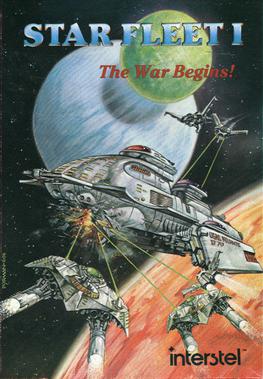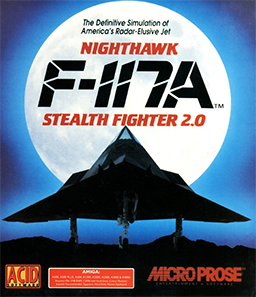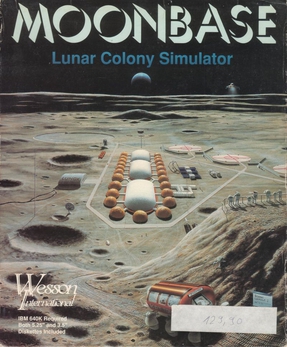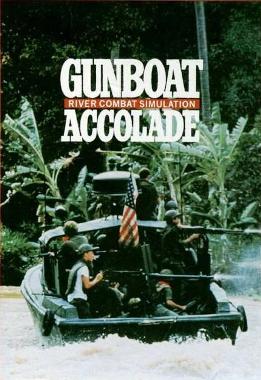
688 Attack Sub is a submarine simulator video game designed by John W. Ratcliff and Paul Grace and published in 1989 for MS-DOS and in 1990 for Amiga by Electronic Arts. A Sega Genesis version developed by MicroProse was released in 1991 by Sega.

Gunship is a combat flight simulation video game developed and published by MicroProse in 1986. In the game, controlling a simulated AH-64 Apache helicopter, players navigate through missions to attack enemy targets and protect friendly forces. Commercially and critically successful, Gunship was followed by Gunship 2000 and Gunship!.

Roadwar 2000 is a 1986 video game published by Strategic Simulations, Inc. It is a turn-based strategy game set in a post-apocalyptic future which resembles the world portrayed in the Mad Max films.

A-10 Tank Killer is a 1989 combat flight simulation video game for DOS developed and published by Dynamix. An Amiga version was released in 1990. The game features an A-10 Thunderbolt II attack aircraft. Following the success of Red Baron, version 1.5 was released in 1991 which included Gulf War missions and improved graphics and sounds. Several mission packs were sold separately. A sequel published by Sierra, Silent Thunder: A-10 Tank Killer II, was released in 1996.

Castles II: Siege and Conquest is a 1992 real-time strategy game for the MS-DOS, developed by Quicksilver Software and published by Interplay Productions. Castles II is the sequel to the 1991 game Castles. Ports for the Amiga CD32, FM Towns, NEC PC-9801 were released in 1993. DOS CD-ROM version and Macintosh port were released in 1994. The Macintosh version of the game was published by Interplay's MacPlay brand name. GOG.com released an emulated version for Microsoft Windows in 2008.

Strike Fleet is a 1988 video game developed by Lucasfilm Games and published by Electronic Arts. It was released for the Amiga, Apple II, Atari ST, Commodore 64, and MS-DOS. Strike Fleet is the unofficial sequel to the war game PHM: Pegasus.

RoboSport is a 1991 turn-based tactics computer game. It was created by Edward Kilham and developed and published by Maxis.

Flames of Freedom is a first-person shooter role-playing video game with simulation elements developed by Maelstrom Games and published by MicroProse for MS-DOS, Amiga, and Atari ST in 1991. It is a sequel to the 1989 game Midwinter and its working title was Wildfire. The Amiga version was re-released by Kixx XL in 1993.

Cyber Empires is a strategy/top-view fighting game produced by Silicon Knights. The game was produced in MS-DOS, Atari ST and Amiga versions, and was originally released in March 1992. The current copyright holder was Strategic Simulations, Inc., which later became part of Ubisoft.

Nuclear War is a single player turn-based strategy game developed by New World Computing and released for the Amiga in 1989 and later for MS-DOS. It presents a satirical, cartoonish nuclear battle between five world powers, in which the winner is whoever retains some population when everyone else on earth is dead.

F29 Retaliator is a combat flight simulator video game developed by Digital Image Design and published by Ocean Software in 1989 Amiga and Atari ST, 1991 for the PC, and for the FM Towns and NEC PC-9801 in 1992-1993. Its working title was just Retaliator. The game was developed during the end of the Cold War, based mostly on speculations on then-future aircraft that were expected to be in use by the year 2002, in particular based on the design of the Lockheed Martin F-22 and the Grumman X-29A.

Starfleet I: The War Begins is a 1984 strategy computer game designed by Trevor Sorensen and developed by Interstel. It was released for Apple II, DOS and Commodore 64. Versions for the Commodore 128, Atari ST and Atari 8-bit family were released in 1986 and versions for the Amiga and Macintosh were released in 1987. The game was successful enough to spawn sequels which are collectively known as the Star Fleet series.

F-117A Nighthawk Stealth Fighter 2.0 is the 1991 remake of the 1988-1990 Cold War combat flight simulator video game F-19 Stealth Fighter by MicroProse, itself a remake of the 1987's Project Stealth Fighter. The original PC version was updated with a corrected aircraft model once the Lockheed F-117 Nighthawk was declassified and with 256-color VGA graphics instead of the original's 16-color EGA, among other changes.

Flight of the Intruder is a flight simulator developed by Rowan Software and published by Spectrum HoloByte in 1990 for MS-DOS, Amiga, and Atari ST. It was ported to the Nintendo Entertainment System in 1991 with Imagineering as the developer and Mindscape as the publisher. The game is based on the novel of the same name and received as the successor of the first game of the Falcon video game series.

Moonbase is a 1990 city-building game set on the Moon. Developed by Wesson International, it was published for Amiga and MS-DOS. An updated version, called Lunar Command, was published in 1993 by Mallard Software.

MiG-29 Fulcrum is a combat flight simulator video game released by Domark in 1990 for the Acorn Archimedes, Amiga, Atari ST and MS-DOS PC platforms.

Halls of Montezuma: A Battle History of the U.S. Marine Corps is a strategy video game developed by Strategic Studies Group in 1987 for the Apple II. Ports were later released for the Commodore 64, Amiga, DOS, and Apple IIGS. Halls of Montezuma is a war simulation game that offers all of the major battles involving the U.S. Marine Corps.

Breach 2 is a science fiction strategy video game developed by Omnitrend Software in 1990 for the Amiga, Atari ST and MS-DOS. It is the sequel to the 1987 game Breach, and was itself followed by Breach 3 in 1995. The game is set in the universe of Omnitrend's Universe and Rules of Engagement, and is compatible with both Rules of Engagement games.

Gunboat is a simulation video game developed and released by Accolade in 1990 for MS-DOS. Ports were released for the Amstrad CPC, ZX Spectrum, Amiga and TurboGrafx-16. It is a combat simulator of a Patrol Boat, River (PBR).

Hyperspeed is a space combat role-playing video game developed by MicroProse Software in 1991 for DOS, and is a sequel to Lightspeed.




















